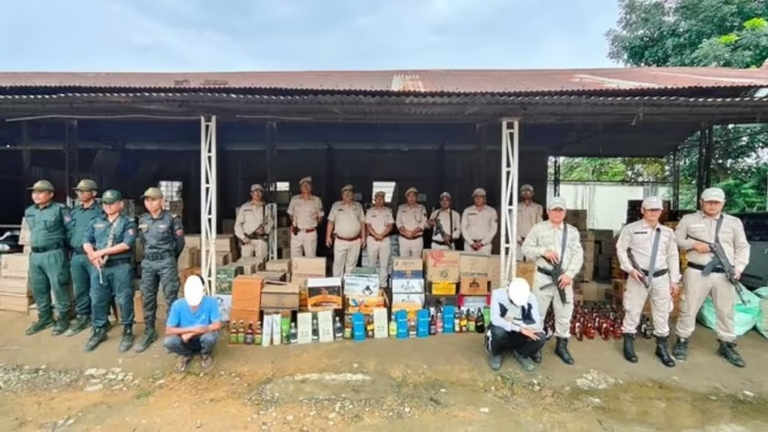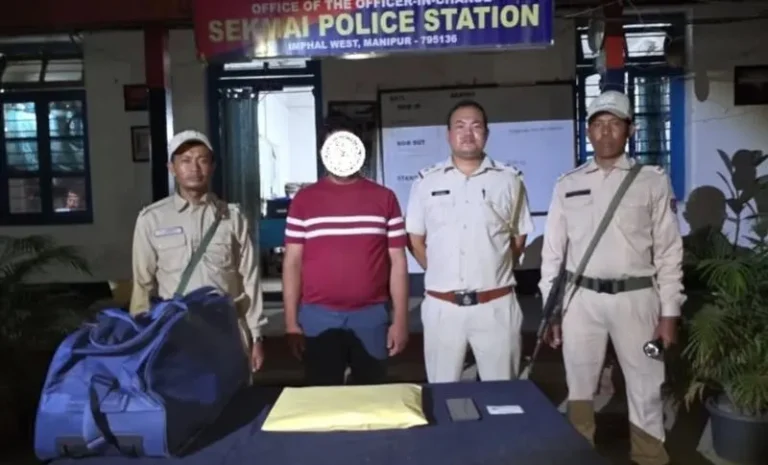Manipur Police Arrest Two Extortionists in Kangpokpi, Seize Firearms
Quick News Summary (One Short Paragraph)
In a surprise intelligence-led operation in Kangpokpi district, Manipur Police’s Anti-Extortion Unit arrested two suspects — identified as Paominthang Kipgen (32) and Seigoulal Kipgen (33) — and recovered a 12-bore single-barrel rifle and a locally made Pompi gun. The arrests, made in Keitheeithelmanbi Vengpi and followed by a search near the Singda River at Konsakhul, were prompted by information that the duo were involved in extortion using threats, intimidation and online methods; they have been charged under relevant sections of the Bharatiya Nyaya Sanhita (BNS), 2023 and handed over to local police stations for further legal action.
Introduction — Why this matters (and why you should care)
Crime stories can read like a mystery novel, but this one is closer to a daily-life worry: local businesses, market vendors, and residents threatened into paying up by people hiding behind fear — sometimes amplified by the anonymity and reach of the internet. When police step in and make arrests like these, it’s more than a headline; it’s a moment that reveals how law enforcement, technology, and community safety intersect in a district like Kangpokpi. So let’s unpack what happened, why it matters, and what it means for local security and everyday life.
The operation: how events unfolded (a timeline)
Think of the police action like a chess move: intelligence first, swift execution next. Here’s how the sequence played out in straightforward terms:
- Tip or intelligence received: Authorities learned of the presence of anti-social or “anti-national” elements operating extortion schemes in the area. Acting on that lead, a raid was planned.
- Surprise raid by Anti-Extortion Unit: A team from Gamnom Saparmaina Police Station executed a targeted surprise operation in Keitheeithelmanbi Vengpi in Kangpokpi district, leading to the arrest of two suspects.
- Interrogation and follow-up: After the arrests, information from the suspects led police to conduct a follow-up raid at Konsakhul near the Singda River, a forested spot under Leimakhong Police Station jurisdiction. There, officers recovered firearms
- Seizure and handover: The police recovered a 12-bore single-barrel rifle and a locally made Pompi gun, charged the suspects under applicable BNS provisions, and handed both the accused and seized weapons to respective police stations for legal processing.
That’s the operational spine — clean, quick, and informed by actionable intelligence. It’s the sort of response police aim for when the risks include intimidation, extortion, and the circulation of crude firearms.
Who were the arrested — names and local ties
Naming matters in journalism because it ties action to accountability: the two arrested were identified as Paominthang Kipgen (32) from Molhoi village (Churachandpur district) and Seigoulal Kipgen (33) from Molnoi village (Kangpokpi district). Their arrests in Keitheeithelmanbi Vengpi and subsequent leads that pointed to caches near the Singda River illustrate a cross-district element — suspects with local roots but mobility across nearby rural pockets
This regional link matters because extortion networks often exploit local geography and community ties: a suspect can move between villages, hide weapons in forested areas, or leverage rural road networks to evade detection. The follow-up raid in a forested area underscores that pattern.
What was seized — weapons, not just words
The seizure details are stark: a 12-bore single-barrel rifle (a fairly lethal weapon at close range) and a locally made Pompi gun. Locally manufactured firearms — sometimes crude but effective — are common in rural or conflict-affected areas where regulated access to weapons is limited and illicit markets fill the gap. Confiscating these firearms does three things: it cuts immediate threat capability, gathers evidence for prosecution, and provides leads into weapon supply chains.
Why is the type of weapon important? Because a single-barrel 12-bore can be used for intimidation and violence, while improvised weapons like a Pompi gun indicate local manufacturing skills and possibly a wider informal supply network. Both are red flags for escalating criminal capacity.
FAQs
1) Who were arrested and where were they caught?
Two men — Paominthang Kipgen (32) from Molhoi village (Churachandpur) and Seigoulal Kipgen (33) from Molnoi village (Kangpokpi) — were arrested during a surprise raid in Keitheeithelmanbi Vengpi, Kangpokpi. Police later conducted a follow-up operation near the Singda River that led to weapon recoveries.
2) What weapons were recovered and why does that matter?
Officers seized a 12-bore single-barrel rifle and a locally made Pompi gun. The combination of a commercially produced firearm and a locally fabricated weapon suggests multiple sourcing channels for weapons — a sign of potential organized procurement or local manufacturing.
3) Under which law were the suspects charged?
They were charged under relevant sections of the Bharatiya Nyaya Sanhita (BNS), 2023, which covers crimes like extortion and illegal possession of weapons.
4) Were victims threatened online or only in person?
Police reported that extortion activities included online elements in addition to threats and intimidation. This mix of digital and physical coercion complicates detection but provides digital evidence opportunities if victims save messages and call logs.
5) What should local businesses do to protect themselves?
Don’t pay silently. Preserve threatening communications, report promptly to the police, use community networks for mutual protection, and adopt simple security measures. Authorities can act only if incidents are reported and supported by evidence.



